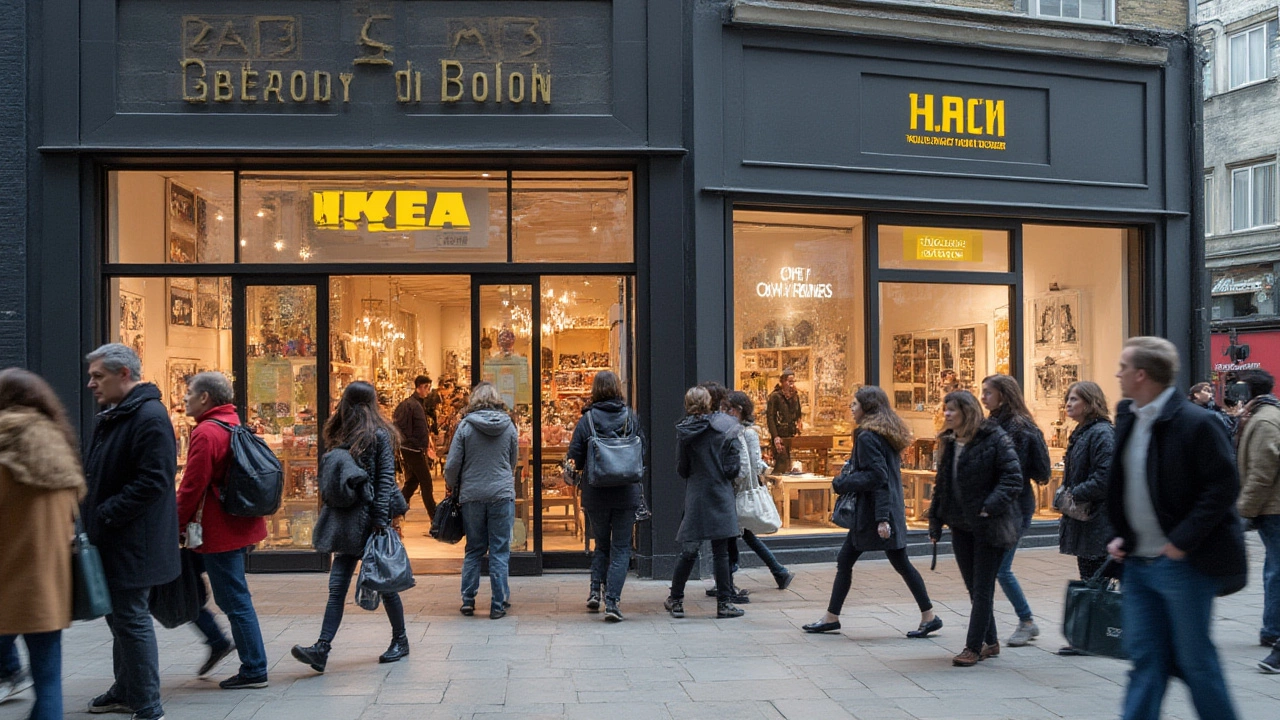Picture this: a Saturday afternoon, and you walk into IKEA, expecting a quick shopping trip, but end up wandering for hours among flat-packed dreams, Swedish meatballs, and the perpetual promise of a tidy, modern home. We've all been there. But if you're wondering who dares to take on this blue-and-yellow furniture behemoth, you're not alone. With its grip on affordable, self-assembled furniture, IKEA has left many rivals in the dust, but one competitor consistently pops up in conversations: Wayfair.
Why Wayfair Ranks as IKEA’s Fiercest Challenger
Wayfair isn’t just another online furniture store—it’s a straight-up juggernaut, especially in the U.S. If you compare numbers, Wayfair’s sales knocked on the door of $12 billion in 2023, creeping up fast on IKEA’s global revenue. What really sets Wayfair apart? For one, their digital-first approach. While IKEA sticks to its massive warehouse stores and a digital shop that often feels more like a catalog than a flexible ecommerce platform, Wayfair is all-in on building a digital playground for home inspiration. You scroll, you click, you ship. Simple.
Let’s talk about selection. While IKEA’s catalog is vast, it operates within a restrained Scandi-modern style, with most pieces having that clean, approachable, sometimes minimalist look. Wayfair, meanwhile, goes wild with variety—quirky ottomans, classic country beds, mid-century sofas, you name it. In fact, as of late 2023, Wayfair listed over 22 million items from thousands of suppliers. IKEA’s range? Around 12,000 products, mostly under their own umbrella. That variety gives shoppers room to explore personal style beyond the minimalist box.
But here’s the catch—Wayfair doesn’t have that in-store experience. You don’t get to plop into the couch in person or test kitchen drawers. You’re buying based on photos and customer reviews. IKEA, on the other hand, seduces you with its maze-like floorplan, layouts you can step into, and, honestly, a vibe. Sometimes, that’s enough to keep people coming back, even if Wayfair wins on raw product numbers.
Another angle: price. IKEA is famously cheap—it's built its entire brand around affordability and transparency, down to the iconic product tags. Wayfair can undercut and sometimes beat IKEA with regular discounts, price-matching, and endless “limited-time” sales. The difference? IKEA’s pricing is consistent; Wayfair’s feels like a sale every day but can swing wildly. If you’re the kind to chase deals, Wayfair hooks you up. If you want reliability, IKEA’s got your back.
Convenience is also a big deal. Assembly is unavoidable for flat-pack furniture, but Wayfair often outsources shipping directly from third-party partners, and logistics can be a mixed bag—some people get pieces in two days, others wait weeks. IKEA’s store-to-home shipping isn’t always fast, and its furniture, while simple, sometimes turns assembly into a weekend project from hell (just ask my wife, Melanie, about the Billy bookcase saga). Wayfair is slowly rolling out pro-assembly services in key metro areas, while IKEA partners with TaskRabbit, trying to make the hands-on part less painful.
Key Differences In Shopping Experience and Customer Loyalty
Shopping at IKEA is almost a rite of passage, especially for first apartments, dorm rooms, and starter homes. The layout guides shoppers through each decorated corner, sparking, “What if our living room looked like this?” Even the food—who hasn’t grabbed those famous Swedish meatballs or almond cake? It feels like a day out, not just a shopping trip.
Wayfair flips the script. Shopping there happens from the comfort of your sofa (or bed, or bathtub—no judgment). The platform uses data-driven algorithms to fine-tune recommendations, nudging you toward trends based on your past clicks. The website is flooded with reviews and real-customer photos, so you scroll endlessly, peeking at how items actually look in someone’s home. This peer validation builds trust even before you hit ‘Buy.’
And speaking of trust, IKEA’s warranty and return policies are pretty straightforward: simple refund, regular restocking fees after a window, and straightforward customer service at the returns counter. Wayfair’s process is mostly online, sometimes more automated, and customers have reported mixed experiences—some praise flawless refunds, others vent about return shipping. If you’re not a fan of returning big-box items via UPS or FedEx, you’ll feel the pain.
Loyalty programs are another battleground. IKEA Family offers discounts, exclusive events, and free coffee in-store—nothing fancy, but something physical and local to keep you coming back. Wayfair’s MyWay gives members perks like free shipping and discounts, but you have to pay a yearly fee. Does it pay off? For frequent shoppers it can, but if you’re just looking for a new coffee table, you might skip it.
As for apps and tech, Wayfair is miles ahead. Their augmented reality feature lets you see what that new chair will look like in your real room via your phone’s camera—a killer move for indecisive buyers. IKEA’s Place app does something similar, but the tech is clunky compared to Wayfair’s faster, more seamless rollouts.

Product Range, Design, and Customization: Who Does It Better?
When you talk about selection, IKEA has a tightly curated range—every item is designed in-house, focused mostly on practicality, space-saving, and modern family living. The look: always clean, functional, and often playful. Colors might shift each year, but the essence? It’s fundamentally the same—minimal, fresh, unfussy.
Wayfair is a bazaar by comparison. From artsy accent chairs handwoven in Vietnam to farmhouse chic dining tables, if you imagine it, it’s probably listed. Customization is where Wayfair pulls ahead—you dig through thousands of color or fabric options, swap table leg finishes, and go granular in ways IKEA rarely allows (unless you’re hacking IKEAhacks on Instagram).
The downside is you can get lost in option overload. Want a navy couch? Try wading through 1,000+ hits, each with slight variations in size, fabric, price, and customer rating. IKEA, on the other hand, limits your choices. Love or hate it, the streamlined approach keeps decision fatigue at bay.
Then there’s the topic of sustainability. IKEA pushes its eco-credentials hard—75% of their range in 2023 used renewable or recycled materials, and they’re aiming to be climate-positive by 2030. They tout ethical sourcing and invest big in green energy. Wayfair is working to catch up, emphasizing responsible sourcing and eco-friendly brands within their colossal catalog, but they’re not leading the industry like IKEA is in this space.
Check out the quick comparison below:
| Feature | IKEA | Wayfair |
|---|---|---|
| Product Count (2023) | ~12,000 | 22 million+ |
| Store Type | Physical & online | Online only |
| Main Style | Scandinavian, minimalist | Any style, from classic to modern |
| Assembly | DIY, TaskRabbit | DIY, pro assembly in select areas |
| Sustainability | High focus | Increasing efforts |
| Loyalty Program | Free, in-store perks | Paid, shipping perks |
Global Reach: Who Owns the Furniture Market Elsewhere?
It’s easy to think furniture retail is just IKEA vs. Wayfair, but different continents tell different stories. In Europe, IKEA rules the roost—its headquarters are there, after all. No American retailer quite touches IKEA’s network of stores in Germany, France, or the UK. Locally popular chains like Conforama (France) or JYSK (Denmark) nibble at IKEA’s audience, but don’t come close in scale or global cool factor.
In the U.S., the battleground broadens. Besides Wayfair, brick-and-mortar giants like Ashley HomeStore and Rooms To Go hold their own, selling mid-range furniture to millions. Target and Walmart chip away at budget shoppers, especially with new in-house furniture brands. But no one meshes global reach, strong private label, and a unique shopping experience quite like IKEA.
Asia’s market is more fragmented. IKEA makes bold moves in China and India, opening giant city-outskirt warehouses, but faces intense competition from local e-commerce players like Taobao or Pepperfry, who focus on rapid home delivery and style variety, often with a local flavor. Japan has Nitori, sometimes called “the IKEA of Japan,” pushing similar minimal designs, and taking a strong local share. Still, none challenge IKEA’s combination of global presence, supply chain, and branding.
For a quick look at market presence:
| Region | Leading Competitor | Notes |
|---|---|---|
| North America | Wayfair | Strongest online rival to IKEA |
| Europe | Conforama, JYSK | Local chains, lower scale |
| Asia | Nitori, Taobao | Regional giants, not global |
Even with these players, IKEA’s universal brand—easy to pronounce, distinctive look, flat-pack charisma—still stands out. But in the digital world, Wayfair’s relentless expansion and tech prowess mean they’re breathing down IKEA’s neck, especially with a younger generation who shops from their phone first.

Insider Tips for Getting the Best from Both Stores
If you’re torn between IKEA and Wayfair, maximize the strengths of each. Here are some street-smart tips that’ll help you score the best deals and avoid the usual pitfalls:
- Check both websites for price drops: Wayfair offers flash sales, but IKEA rarely changes its prices, except for seasonal events. Use sites like Honey or CamelCamelCamel to track price histories.
- Read reviews on Wayfair—and photos matter. Some items look perfect in the promo shot but not so much in a real apartment. Scroll through customer uploads for the real deal.
- IKEA’s ‘As-Is’ section (both online and in store) is the holy grail for bargain hunters. Slightly scratched? Maybe. Half price? Often.
- Wayfair’s MyWay subscription can pay off if you plan to buy bulky items or fill a whole home. Calculate the cost vs. shipping fees before clicking join.
- Don’t skip IKEA’s assembly services if time (or marital harmony…) matters. The small added fee often saves tons of headache—learned that one the hard way.
- For custom upholstery, Wayfair’s filtering tools let you sort by fabric, size, and color, getting you as close to bespoke as mass production allows.
- Pair IKEA basics with Wayfair accent pieces for a look that feels less ‘catalog’ and more curated. IKEA’s couches, Wayfair’s throw pillows? That’s my living room.
In a nutshell, if you want hands-on shopping, strong sustainability, and streamlined decision-making, IKEA stays king. But if you want endless variety, online ease, and fresh tech, Wayfair is the biggest name fighting for IKEA’s crown in 2025—and the competition makes the furniture world more fun for all of us.



